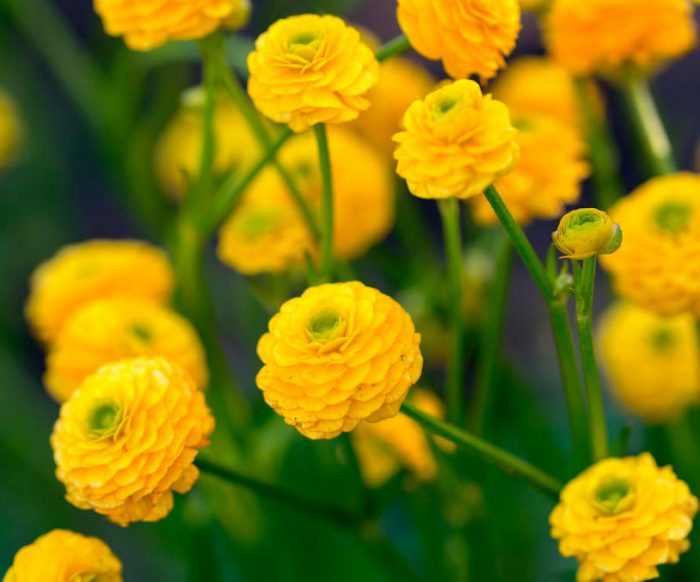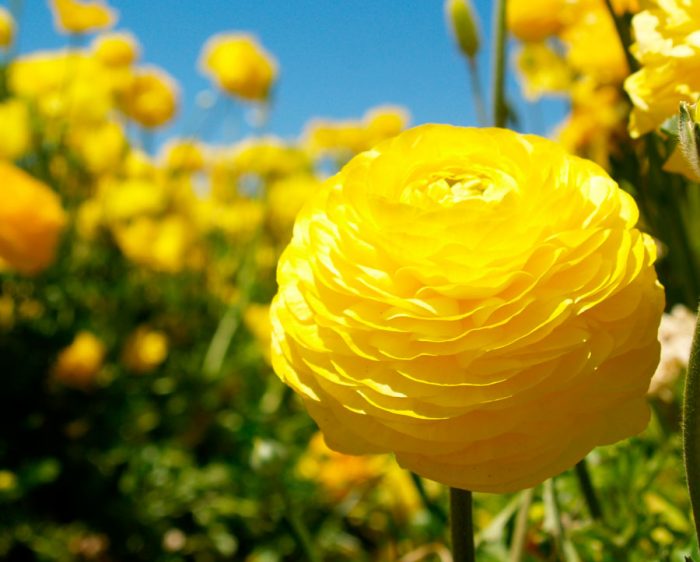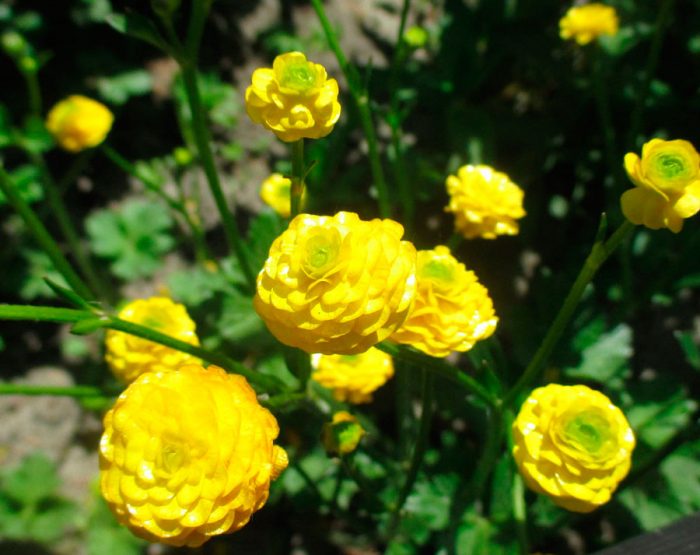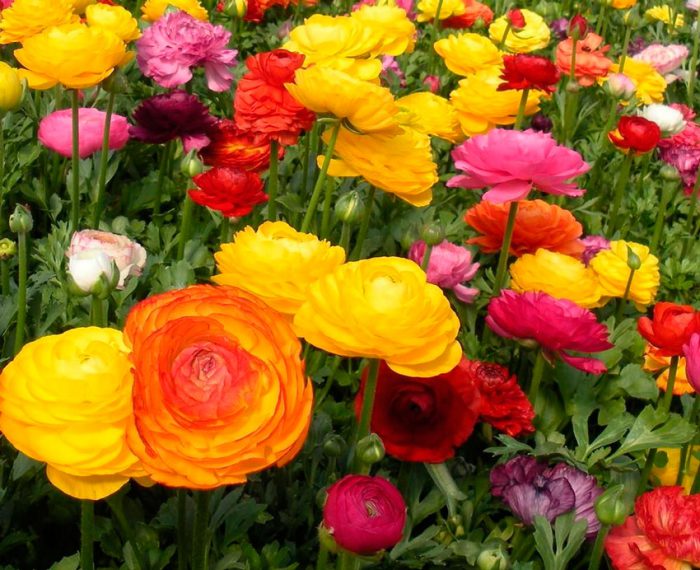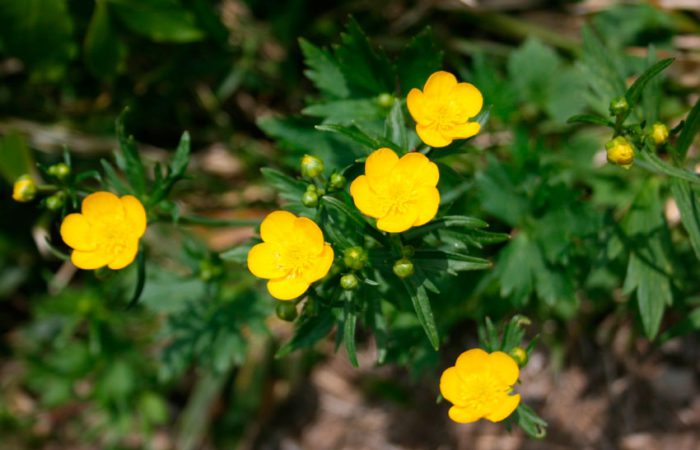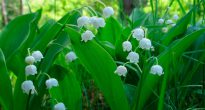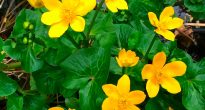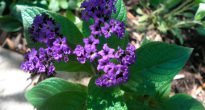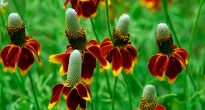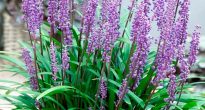The herbaceous perennial plant, the buttercup, or ranunculus (Ranunculus), is part of the Buttercup family. The name of the genus comes from the word rana, which translates as "frog". This is due to the fact that buttercups prefer to grow near bodies of water or even in water. All species included in this genus have one distinguishing feature - poisonous juice. Because of this, any part of such a flower is poisonous.
This genus unites approximately 360 species, they can be found in natural conditions in the Northern Hemisphere in regions with a cold and temperate climate. The most widely spread in the culture is the garden buttercup, or the Asiatic. Such a plant has many varieties and varieties that look very impressive in the garden during flowering. The bushes bloom in mid-July, and their flowering lasts about four weeks. The garden buttercup bears little resemblance to the field buttercup or creeping, growing in the wild. It has large bright flowers and blooms magnificently, and this is the result of the work of breeders. In culture, buttercup began to be grown in the second half of the 16th century. And already in the last years of the 17th century, he and his hybrids have become very popular among gardeners, just like carnations or tulips.
Content
Brief description of cultivation
- Sowing... For seedlings, sowing seeds is carried out in the first days of spring, and the grown seedlings are transplanted into the garden at the end of spring.
- Digging... In August or September.
- Storage... The tubers are stored in the cold (from 4 to 5 degrees), having previously folded them in a perforated paper bag.
- Bloom... June to August.
- Illumination... Shaded or sunny area.
- Priming... It should be nutrient-dense, light, well-drained, and moderately acidic. Loam is not suitable for such a plant.
- Watering... Systematic and moderate.
- Fertilizer... During the period of active growth of greenery, the bushes are fed with nitrogen-containing fertilizers twice a month. And flowering bushes need phosphorus-potassium fertilizers.
- Reproduction... Seed method and tubers.
- Pests... Spider mite, cabbage butterfly and nematode.
- Diseases... Powdery mildew, root rot and gray rot.
Features of buttercups
The garden buttercup is a herbaceous perennial, the average height of which is about 0.65 meters. The fleshy rhizome has a tuberous shape. The branching leafy stem is decorated with leaves of a tripartite shape, somewhat reminiscent of the foliage of a dahlia. In diameter, the flowers can reach from 80 to 100 millimeters, depending on the variety, they are double, simple and densely double.The color of the flowers is diverse, they can have such color shades as: salmon, red, cream, white, purple, pink, orange, yellow, etc. There are flowers of a two-tone color, but so far there are no blue and blue varieties. The flowers are great for cutting because they retain their freshness for a long time (at least 7 days).
If you decide to decorate your garden with buttercups, then remember that there is poison in all parts of this plant. That is why pets and small children should be kept away from him.
Growing from seeds
Garden buttercups are grown from seeds or propagated by tubers. Experienced gardeners are advised to buy seeds in flower shops. The fact is that do-it-yourself seed material has a low germination rate. And collecting seed from such a plant is not at all easy.
This flower is grown through seedlings. Seed material is sown at the end of winter or early spring. Fill the box with a light, loose soil mixture made up of sand, leafy and peaty soil (1: 2: 2). Spread the seeds evenly over the surface of the substrate, and then sprinkle them on top with a thin layer of earth. Moisten crops with a sprayer.
The seedling box should be covered with foil or glass on top, after which it is removed to a cool place (from 10 to 12 degrees). Do not forget to arrange regular ventilation, and also remove condensation that has appeared on the surface of the shelter. The first seedlings should appear 15–20 days after sowing. As soon as this happens, transfer the crops to a well-lit and warm (about 20 degrees) place. A southern window sill is perfect for this, only crops should be shaded from direct sunlight. Be prepared to provide additional lighting for the plants if necessary.
When 4 or 5 true leaves are formed in the plants, they are subjected to a pick. For this, peat-humus pots are used.
Landing in open ground
Choosing a suitable site
The grown and matured seedlings of the garden buttercup are transplanted into the garden at the end of the spring period. Remember that they can be harmed by return frosts, so planting is carried out only after it finally gets warmer.
These spectacular flowers grow normally in both light shaded and well-lit areas, with reliable protection from strong gusts of wind and drafts. The soil should be light, fertile and water permeable, as well as slightly acidic or neutral (pH 5.5-6.6). It should also be moderately moist, because rot appears on the roots of the plant in excessively moist soil.
Basic landing rules
Dig up the soil on the site and make holes, while the distance between them should be from 15 to 20 centimeters. At the bottom of each hole, a thin layer of drainage is made; for this you can use expanded clay or sand. Place the plant in the hole along with the peat-humus pot. In the event that you dived the seedlings into plastic cups, they are planted in the ground by transshipment. Take a seedling along with a lump of earth and set it in a hole. All voids in the hole are filled with garden soil, after which its surface is slightly tamped. Be sure to water the planted buttercups well. Bushes grown from seed usually bloom for the first time in the second year of growth.
Buttercup care
You need to take care of garden buttercups in almost the same way as for other flowers grown in the garden. Systematic watering and loosening the soil surface, removing weeds, feeding, protecting the plant from diseases and pests - this is the main care of buttercups. Remember that this is a rather aggressive crop, so it is capable of displacing other plants that are next to it and occupying territories that are not intended for it. Therefore, you will have to systematically control the wild growth of the buttercup.
Watering
When growing this crop, special attention should be paid to watering. They should be systematic, while remember that such flowers react negatively to both slight drought and stagnant liquid in the root system.
Top dressing
During the active growth of foliage, buttercups require systematic feeding with nitrogen-containing fertilizers, for example, you can use Kemiru-universal. From the moment bud formation begins, phosphorus-potassium fertilizers are used for dressing. Any feeding is carried out at intervals of 2 times a month.
Diseases and pests
Buttercups are very resistant to both pests and various diseases. But this is only if you water the bushes correctly. If, due to excessively frequent watering, water stagnates in the roots, this can lead to the development of root rot. That is why do not forget about good drainage when planting seedlings in the soil. If the summer is rainy, then because of this, the flowers may suffer from powdery mildew. Also, the rhizome of buttercups is sometimes damaged by nematodes, and foliage - by cabbage butterflies. To get rid of pests, it is recommended to use bioinsecticides.
Post-flowering care
After flowering is over, you should begin to gradually reduce the abundance and frequency of watering. And after all the foliage turns yellow, the bushes stop watering at all.
The tubers are excavated in August or September. Then they are thoroughly dried and the remaining soil is carefully removed. Put the tubers in small boxes in one layer, after which they are removed to dry in a well-ventilated room, where the air temperature should be about 20 degrees. Dried tubers are laid out in perforated paper bags and stored until spring. Buttercup tubers need to be worked very carefully, as they are rather fragile.


Watch this video on YouTube
Types and varieties of buttercups
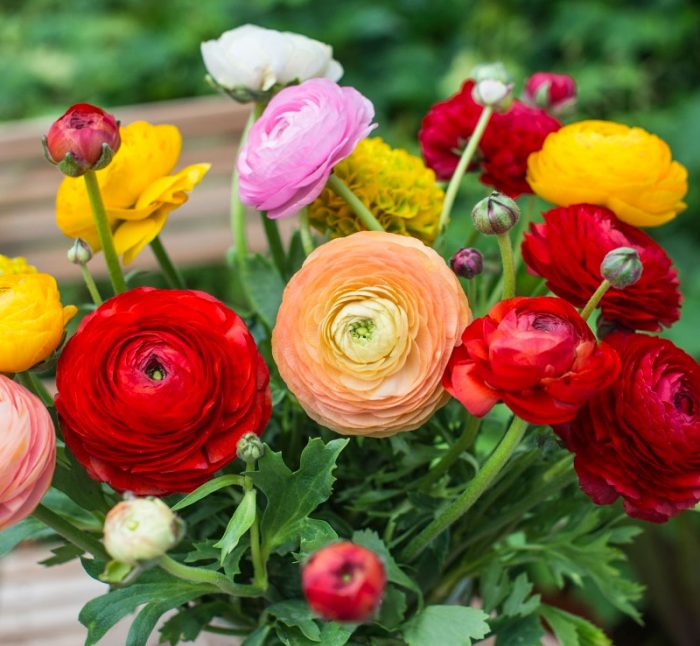

Gardeners are often cultivated garden buttercup (Ranunculus asiaticus), which is also called Asian buttercup, hybrid buttercup or Asian ranunculus. This species has become so popular due to the fact that it has a huge number of forms, as well as varieties that are distinguished by a rich selection of attractive flower colors. There are also many hybrids. And the flowers of this plant are used for cutting. The forms and varieties of Asian buttercup are divided into 4 groups according to the shape of the flowers:
- Buttercup African (turban)... Dense double variety with spherical flowers.
- French buttercup... Semi-double, flowers have only 2 rows of petals.
- Persian buttercup. A low-growing plant with semi-double or simple flowers.
- Buttercup peony... Double flowers are large enough.
The most popular among gardeners are varieties such as:
- Bloomingdale Rose Bicolor... Double white flowers have petals with a pinkish edge.
- Pearl Pikoti... The white flowers at the ends of the petals have a spray of purple color.
- Double Pink Buttercup... The petals of densely double pink flowers are very tight.
The following types of buttercup are also cultivated:


- Buttercup aconitol, or borecelist (Ranunculus aconitifolius). The bush can reach a height of about 100 centimeters. The color of its flowers is white. There is a variety with double flowers, as well as with flowers of a very beautiful yellow-golden color.
- Anemone-leaved buttercup (Ranunculus anemonifolius). The height of the bush reaches 0.3 meters, the color of the flowers is yellow. There is a form with white flowers.
- Caustic buttercup (Ranunculus acris). Only terry forms of this species are cultivated. Large flowers can be colored in a wide variety of shades of yellow.
Also cultivated are such species that are found in the wild, such as: Kamchatka buttercup, Illyrian buttercup, sulfur-yellow buttercup, Haast buttercup, Alpine buttercup, Altai buttercup, Pyrenean buttercup and Gray buttercup.


Watch this video on YouTube

